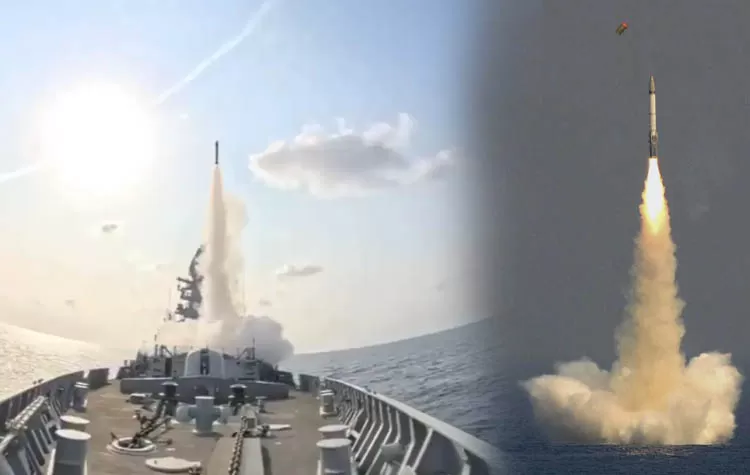
Indian Navy has exhibited cutting-edge missile capability in an important test during the backdrop of increased tensions against Pakistan. There has been a record set regarding neutralizing low-flying aerial target by INS Surat utilizing a Medium Range Surface to Air Missile (MR-SAM). The exercise conducted in the Arabian Sea demonstrates the readiness of India to neutralize next-generation airborne threats, such as drones and sea-skimming missiles that can't be seen by radar.
This defense action comes on a day when there is more alertness in the wake of the Pahalgam terror attack. At a time when Pakistan is veiled threats for conducting future missile tests, the rapid military response by India suggests a broader strategy of defense in securing sea boundaries and preventing impending aggression.
INS Surat Depicts Precision During Live Fire Exercise
Indian Navy guided missile destroyer INS Surat achieved a significant operational milestone when it successfully neutralized a simulated aerial target. The target was one of a sea-skimming missile low-flying simulation and was detected and pursued in a coordinated operation by various naval assets. The exercise was wrapped up with an MR-SAM fired successfully at a designated point, testing the effectiveness of the missile system in real-time.
Sea-skimming threats are extremely difficult with their low flying height and radar evading capability. Such simulation ensures through it the Navy's war preparedness against modern airborne intrusions. The mission success validates the strategic importance of MR-SAM systems in India's multi-layered air defense system, particularly over naval domains.
Pakistan Responds with Missile Test Alert
Since the Pahalgam terror attack, Pakistan's defense establishment has put out a NOTAM (Notice to Airmen), announcing scheduled surface-to-surface missile trials on the 24th and 25th of April. It was issued as a countermove after India's saber-rattling naval exercises and is under serious observation from security experts. As a routine drill was claimed, the timing in fact signals that this was by design an exhibit of muscle-flexing amidst tension at the diplomatic level.
India's demonstration of sea-skimming missile defense capability indicates a strategic edge in repelling threats from the sea. With such progress continuing, the region witnesses more military posturing on both sides, raising stakes for regional stability and strategic signaling.
INS Vikrant Enters Arabian Sea Patrols
India's home-grown aircraft carrier, INS Vikrant, has been spotted off Karwar port through satellite photographs. Though having made its deployment in advance announcement, the timing of its deployment happens to overlap directly with recent geopolitical tensions. With an increased naval presence by India, Vikrant patrols bring much-needed deterrence, along with maritime dominance, into the Arabian Sea.
The carrier's deployment by the carrier once again emphasizes India's naval dominance when strategic seas are closely watched and vulnerable to potential risk. Under increased tensions, Indian Navy asset coordination of carriers and destroyers clearly indicates the eagerness of watchfulness and preparedness.














